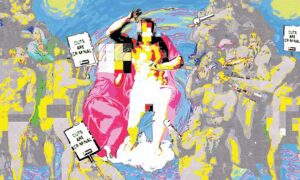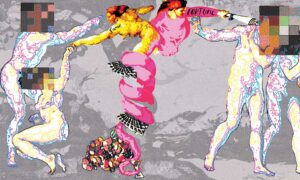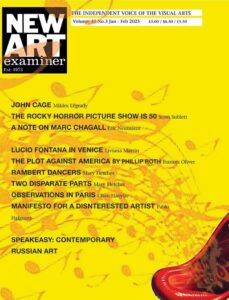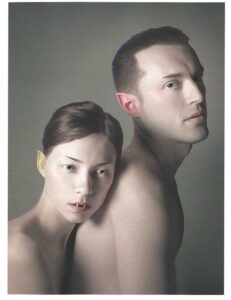
Kat Johnson: Behold

Some of the finest minds in modern history have edited journals, magazines, books or periodicals. They have enriched the cultural legacy of their generations with their virtuosity, fearless opinion and wide-ranging critiques of their generations. It is not a skill I began to develop until I met Derek Guthrie in Penzance, Cornwall and was presented with the opportunity of resurrecting the New Art Examiner. A journal of art criticism that, at its most successful, was the most widely read outside of those published in New York and the most successful to come out of Chicago.
I quickly discovered that editing is not the skill most needed for the modern editor. What is most need is Patience. Patience to heal a culture that has sold the worth of an artist’s work to banks, traded thinking deeply about the visual experience for celebrity, and seduced art students with the irresistible allure of the overriding worth of their own sensibility above knowledge, skill and that most nebulous of all concepts ‘taste’.
The roads of contemporary art, like Priestley’s rolling English drunkard, ramble from Paris to New York by way of St Ives, teeter upon the words of Walter Benjamin and Theodor Adorno before learning to spell Marcel Duchamp and fall into the ditch of mishmashed thinking that has become conceptualism. An art world so divorced from the aesthetic object that it ceases to matter what is made as long as it is commercial. Few are interested in being told that tax funded museums and galleries support rich trustees and billionaire collectors in further enriching their collections at the expense of community artists and the integration of a nation’s conversation with the image as a depiction of their nationhood. The majority of well-known artists have agents and dealers working from accepted seats of power in the art world outside of which artists are barely taken seriously. People don’t want to know that the reason this all matters is because those who know how to market themselves and network, will make millions and be no better artists than many who do not know how to market themselves. That what is sold as the culture of a country, is, in fact, nothing more than part of investment portfolios and at worst money laundering.
Brexit is the fault of the art world and the artists of the past forty years who have allowed themselves to fall into the trap of Orwellian definitions of who they are, instead of learning from history that they are ‘the makers and breakers of the world forever …’ They make exhibitions of the latest tragedy in the world – from Yemen to drowning African migrants, from police brutality to the destruction of oceans – and forget to realise this is nothing but sentimental commentary after-the-fact’. This is social science playing out in a muted art world. Artists have been profound thinkers not mere commentators. They rail, they protest, they stand before the firing squad leaving their blood on the ground as their final works. Take a lesson from the writers, who used to work with artists at all levels. They have tried for years to tell us Lorca was killed because he was homosexual. That is an historian’s legerdemain; he was murdered because he was an important poet and poets educate the generation to come on how to make world anew. ‘Would not we take this sorry scheme of things entire and shatter it to bits, remoulding it nearer to the hearts desire?’ If a painting is another way of thinking then, by extension, every single artwork is a potential revolution of society herself. More than a metaphor it is a series of realised emotions caught by the artist and offered to the viewer. It is the truth ‘when most denied, most alive’.
As we republished the New Art Examiner from 2015 and struggled to find writers, we discovered that in St Ives in Cornwall, once the avant garde and set to be so again, truth tellers are unappreciated. After selling a few copies we printed a review that was not positive about a Penwith Gallery exhibition. The copies of that issue were taken out of the Gallery, never paid for, and the Gallery refused to stock the magazine again. Exactly the same thing happened with the Newlyn Orion when we were told that they would not stock magazines that were not in line with their exhibition policy. Tremenheere Sculpture Gardens told us they didn’t want a magazine in their shop that was saying negative things about ‘their colleagues’ at Newlyn Orion. Even the art hotel in Penzance, a place you would think the patrons would enjoy reading an international magazine of art criticism published on their doorstep, told us it wasn’t for them.
The Tate St Ives neither has room to sell any magazines, nor space to invite living artists who were in St Ives at the time it was the avant garde, to speak to its members. It appears there is no interest in hearing what it was like to actually know them, from those who knew them. Ginny Button, the now retired Director of Falmouth University (née Falmouth College of Art) was requested twice if she had time to meet us. The head of a leading art college. She never replied (did she get the messages?). We approached the journalist school at the same college, and were told no meeting would be arranged unless first agreed by senior management. We never heard from them again. We should all be surprised they did not want their students to have access to working with an international journal of art criticism published on their doorstep.

I bow in gratitude to the St Ives Society of Artists, The St Ives Times & Echo and the Belgrave Gallery who have taken every issue and sold many copies, and to St.Eia Cabin and John Bedding’s Pottery Shop and gallery. And in Penzance the Art Shop and Redwing Gallery have headed up the small, elite group that values the wide ranging discussion found in our pages.
Why are we disliked? We say things like more artistic activity has not produced more quality art. It is reported that around the fifteenth year of the Booker Prize Antonia Byatt asked ‘whose turn is it?’ When a culture sinks into self-regard and cliques it takes every art form with it. But the direct way in which Penlee House was turned against the New Art Examiner and the way in which James Green, director of the Newlyn Orion, advised a councillor not to have anything to do with us goes well beyond a corrupt culture. It points to closed minds, to hidden interests and deliberate censorship.
I am not sure why this censorship exists but I think it may have something to do with the huge investment coming into Cornwall from Nicholas Serota and Teresa Gledowe. With tie-ups in funding to the tune of £500,000 at CAST in Helston, to shared trusteeships between Teresa Gledowe and Karen Townshend at Kestle Barton, the Serotas have the whole of Cornwall currying favour. Will is make Cornwall into the avant garde again? Will it produce ‘good’ art. If the YBA is anything to go by the propaganda machine will tell you it’s all brilliant but it may be nothing but fashion.
Why do I say that? What is wrong with investing in Cornwall?
Let’s first of all be clear, this is not investment in Cornwall; this is using Cornwall. Money will flow in, and has already started to, but the millions that could be generated by a new ‘A’ team of artists is not earmarked to be spent in Cornwall on Cornwall. It is investment capital that wants a high yield and a fast return for the investors. The personal wealth of the individuals who will benefit would stagger the average Cornish person and none of them will see a penny of it. Any more than the average Londoner befitted from the YBA’s antics or the average New Yorker became richer because New York became the power house of art after the last world war. Big art business doesn’t have much time for the average person. However, it does know how to use people’s hopes. The hope that art can solve problems, the hope that art can heal, the hope that art is the finest expression of creativity, the better part of the human consciousness, the principle driving force of all that is true. A brilliant self-sacrifice to excellence. Human beings have always had a propensity to worship images, and that makes images very dangerous. There isn’t an image in existence that doesn’t come with a psychological byline at the ready in our heads. Brexit is all about the images millions have in their heads about themselves and the meaning of Country, and nothing to do with reality. And oh, how certain politicians like Johnson and Farage abused those images.
These matters take decades to come to political fruition. While everyone is busy making money they don’t look at the damage they are doing to everyone else. There are some dissenting voices in the 80s and 90s but you have to look in cracking old magazine and fading newspapers to find them. Few remember their names and no one quotes them. Writers like William Honan of the New York Times who wrote in 1993, “Very strange things happen when the government or the academy or whatever it may be asks artists to perform in a certain way and begins to direct their activities.” With the benefit of 25 years we can take out the word strange’ and put in the correct term, ‘neo-fascist’.
Artists are fiddling while culture is burning. Fascism is on the rise, peoples are on the move, the old hatreds are sparking into life and the gatekeepers of our culture: the managers at the Arts Councils, the national museums and art galleries, are broken recordings listing visitor numbers and kitsch sales as advances toward success, equality and the socially conscious generosity of the State.
Art education was once one of the finest educations you could have in the UK as it encompassed everything. Now art students are churned out and from the Royal College downwards they feel unprepared for the life of an artist who is not going to ‘make it’ in their lifetime, and they feel used just to keep faculties open for business. Investment in the arts in Cornwall is not going to change this scheme of things. Nothing happening in the political houses of the EU or USA or Brexit will change anything for the better in the art world as long as artists play the rich man’s game.
We have one hope.
Art is not a status game. Stop looking for the feel-good factor. Start writing. Write down your fears, write down your hopes, write down what you see of the world around in your community and your family. Call out the hypocrisy. Identify the lies. That is what the New Art Examiner will always do and that is why certain organisations will never stock our magazine.
When they do you will know the vital shift into open debate will have begun and the road to artists being in charge of the culture of their countries and not the art managers, will have begun. Working together the promised renaissance in Cornwall could be magnificent.
Daniel Nanavati
European Editor
Volume 33 no 3 January / February 2019 pp 17-19


Good points Daniel, well said.